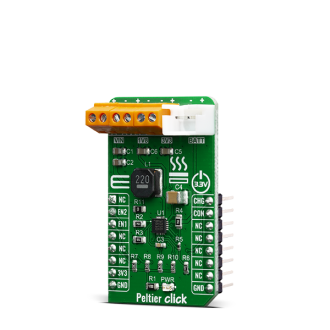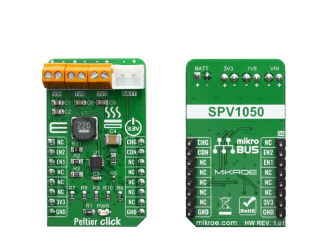
We strongly encourage users to use Package manager for sharing their code on Libstock website, because it boosts your efficiency and leaves the end user with no room for error. [more info]

Rating:
Author: MIKROE
Last Updated: 2019-11-05
Package Version: 1.0.0.0
mikroSDK Library: 1.0.0.0
Category: Battery Charger
Downloaded: 3700 times
Not followed.
License: MIT license
The Peltier Click is a Click board which utilizes the SPV1050, an ultralow power energy harvester and battery charger from STMicroelectronics.
Do you want to subscribe in order to receive notifications regarding "Peltier Click" changes.
Do you want to unsubscribe in order to stop receiving notifications regarding "Peltier Click" changes.
Do you want to report abuse regarding "Peltier Click".


Library Description
The library covers all the necessary functions to control Peltier Click board. Peltier Click communicates with the target board through the RST, CS, PWM and INT pins. This library offers functions for detecting the states of PWM and INT pins and for seting or clearing RST and CS pins.
Key functions:
void peltier_enableLdo2(); - Function is used to enable 3.3V output.void peltier_enableLdo1(); - Function is used to enable 1.8V output.uint8_t peltier_batteryCharge(); - Function is used to check ongoing battery charge flag pin.Examples description
The application is composed of three sections :
void applicationTask()
{
mikrobus_logWrite( " 1.8V output ", _LOG_LINE );
mikrobus_logWrite( "------------------", _LOG_LINE );
peltier_enableLdo1();
peltier_disableLdo2();
Delay_ms( 5000 );
mikrobus_logWrite( " 3.3V output ", _LOG_LINE );
mikrobus_logWrite( "------------------", _LOG_LINE );
peltier_disableLdo1();
peltier_enableLdo2();
Delay_ms( 5000 );
mikrobus_logWrite( " Both outputs ", _LOG_LINE );
mikrobus_logWrite( "------------------", _LOG_LINE );
peltier_enableLdo1();
peltier_enableLdo2();
Delay_ms( 5000 );
mikrobus_logWrite( " Disable outputs ", _LOG_LINE );
mikrobus_logWrite( "------------------", _LOG_LINE );
peltier_disableLdo1();
peltier_disableLdo2();
Delay_ms( 5000 );
}
Other mikroE Libraries used in the example:
Additional notes and informations
Depending on the development board you are using, you may need USB UART click, USB UART 2 click or RS232 click to connect to your PC, for development systems with no UART to USB interface available on the board. The terminal available in all MikroElektronika compilers, or any other terminal application of your choice, can be used to read the message.